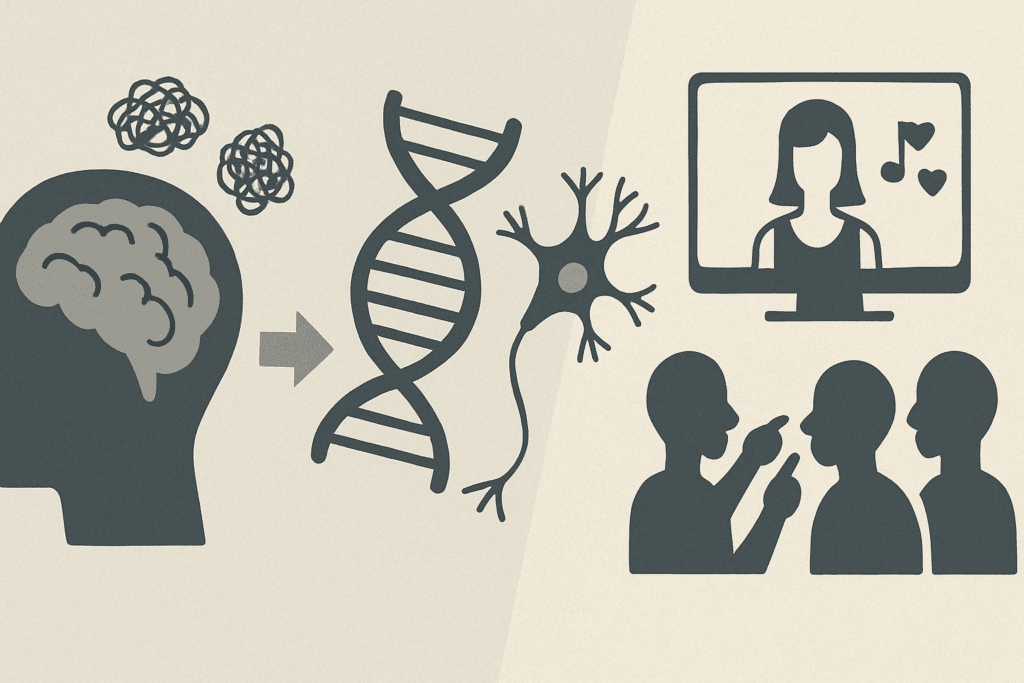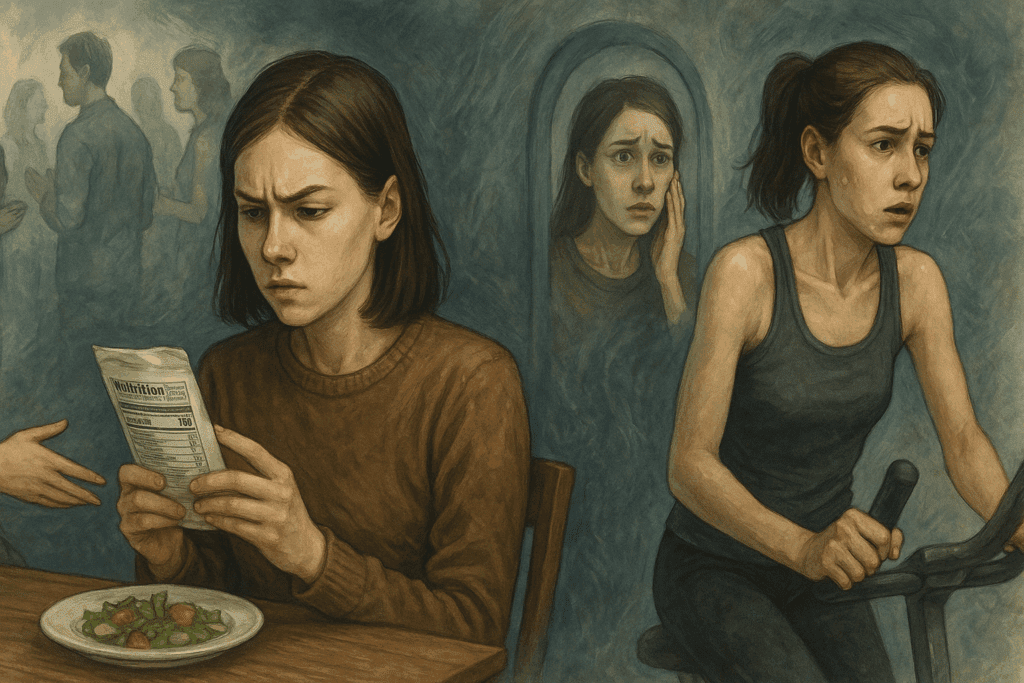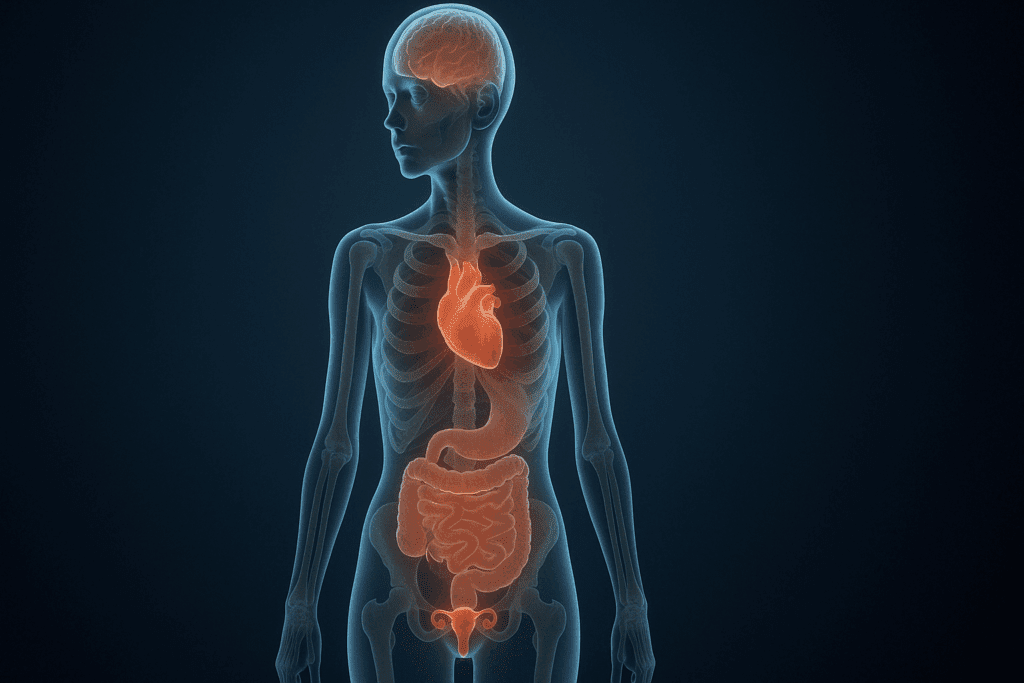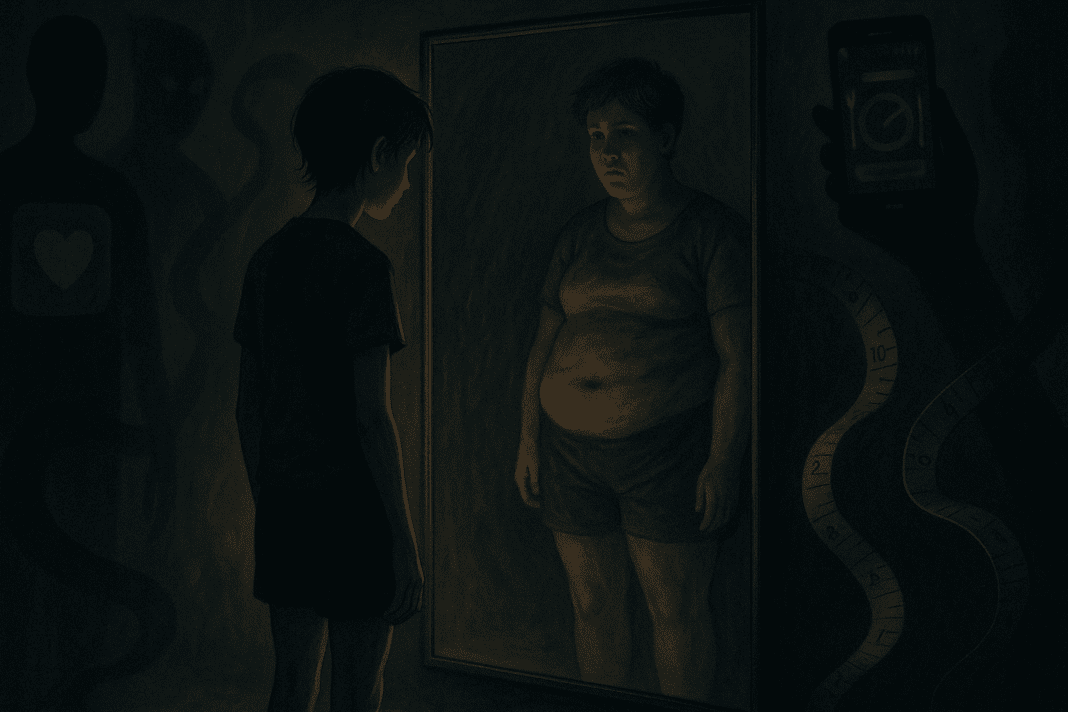Introduction: A Growing Concern in Modern Health and Wellness
The modern landscape of health and nutrition has become a complex web of ideals, trends, and often, hidden struggles. Among the most pressing concerns is the fear of gaining weight and calorie restriction—a behavior that, while often masked as health-consciousness, can lead to severe psychological and physiological consequences. This fear, especially when paired with disordered eating patterns, often signals deeper issues such as anorexia nervosa. Understanding what causes eating disorders and learning how to recognize the warning signs is vital, not only for individuals experiencing these challenges but also for those who care for them. In today’s society, where body image is often idealized and perfectionism praised, it’s important to look past surface behaviors to uncover the motivations and risks behind this mental health condition.
You may also like: How to Stop Emotional Eating and Regain Control: Mindful Nutrition Strategies That Support a Healthier Lifestyle
At its core, anorexia nervosa is a complex and serious illness, rooted in psychological, biological, and social factors. It’s not simply about food—it’s about control, self-worth, and identity. Despite increasing awareness, myths and misinformation continue to circulate, particularly among young adults, who are especially vulnerable to societal pressures. In exploring the warning signs or symptoms of anorexia, one must take a multifaceted approach that considers emotional, physical, and behavioral patterns. This article dives deeply into these complexities, aiming to educate readers on how to know if you have an eating disorder, and what steps can be taken toward recovery and healing.

What Is Anorexia Nervosa? Understanding the Illness Beyond Stereotypes
When addressing the question “what is anorexia,” it is essential to go beyond the simplistic view of someone refusing to eat. Anorexia nervosa is a serious mental health disorder that involves an intense fear of gaining weight and persistent behaviors that interfere with maintaining an adequate body weight. Individuals with this condition may see themselves as overweight even when they are dangerously underweight. This distortion of body image is a hallmark feature, often coupled with extreme calorie restriction, compulsive exercising, and a rigid obsession with food and body shape.
Anorexia nervosa can manifest in different forms, the most commonly recognized being the restricting type. In the anorexia nervosa restricting type, individuals limit their food intake severely without engaging in binge-eating or purging behaviors. Over time, the body’s systems begin to deteriorate due to prolonged nutritional deprivation. The psychological grip of anorexia is powerful; many individuals describe the experience as being overtaken by a voice that insists thinner is better, that fullness equals failure, and that control must be maintained at all costs. This internal narrative is difficult to escape without comprehensive treatment and support.
The social stigma surrounding anorexia often leads to delayed diagnosis and treatment. It is still widely misunderstood as a condition that only affects teenage girls, when in reality, it affects people of all ages, genders, and backgrounds. It is crucial to dismantle these stereotypes to provide equitable care. Anorexia nervosa is not a lifestyle choice—it is a mental illness that requires medical and psychological intervention. By shifting our cultural understanding, we can better support those suffering in silence.

Fear of Gaining Weight and Calorie Restriction: The Hidden Driver of Eating Disorders
One of the most consistent and distressing features of anorexia nervosa is the overwhelming fear of gaining weight and calorie restriction that becomes central to a person’s life. This fear often begins subtly, disguised as a desire to be healthy or in control. However, it can quickly escalate into a harmful obsession. As individuals restrict more and more foods, monitor every calorie, and avoid situations involving food, their world becomes smaller, dominated by anxiety around eating and body image.
This fear is frequently reinforced by societal norms and media portrayals that glorify thinness. Social media, in particular, has amplified these ideals, with influencers and content that often glamorize restrictive eating without acknowledging the physical and psychological damage it can cause. The desire to attain a certain body type can become a dangerous fixation, leading individuals to turn to anorexia as a misguided solution to their fears and insecurities.
What makes the fear of weight gain so insidious is its ability to override logic and self-preservation. Even when faced with the health risks associated with anorexia nervosa, many individuals struggle to let go of the rigid rules they have created. For them, eating becomes a source of shame, guilt, and panic. Understanding how these thoughts develop and are reinforced is essential in breaking the cycle and providing effective support.

What Causes Eating Disorders? Unpacking the Psychological, Biological, and Social Influences
Eating disorders such as anorexia nervosa do not arise from a single cause. Rather, they emerge from a complex interplay of psychological, biological, and social factors. Understanding what causes eating disorders requires examining these elements in detail. Psychologically, individuals who are perfectionistic, anxious, or have low self-esteem are at greater risk. These traits often fuel the desire for control and achievement through the regulation of body size and food intake.
Biologically, research has shown that genetic predispositions and neurochemical imbalances can play a role in the development of anorexia. For example, disruptions in serotonin and dopamine pathways—neurotransmitters associated with mood and reward—can influence eating behavior and body image perception. These biological components may make certain individuals more susceptible to developing restrictive eating patterns in response to stress or trauma.
Socially, pressures from family, peers, and cultural expectations contribute to the onset of disordered eating. From a young age, many individuals are exposed to messages equating thinness with success, attractiveness, and moral virtue. In some environments, discussions around diet and weight are normalized, reinforcing the idea that one must be thin to be valued. The rise of “clean eating” trends and fitness culture can also blur the line between health and obsession, making it harder to recognize when behaviors have turned harmful.
Understanding these root causes helps in forming effective treatment strategies. Rather than focusing solely on food intake, recovery must address the emotional wounds and cognitive distortions that fuel the disorder. Therapy, medical monitoring, and nutritional counseling must work in tandem to rebuild physical health and emotional resilience.

Recognizing the Warning Signs or Symptoms of Anorexia: What to Watch For
Recognizing the early warning signs of anorexia is critical for early intervention and recovery. Many symptoms begin subtly, often mistaken for dedication to health or fitness. Over time, however, they become more severe and all-encompassing. Common warning signs or symptoms of anorexia include dramatic weight loss, preoccupation with calories, fat grams, and dieting, refusal to eat certain foods or entire food groups, and frequent comments about feeling fat despite being underweight.
Emotional and behavioral changes are also significant indicators. Individuals may become socially withdrawn, exhibit rigid food rituals, or express intense anxiety around mealtimes. In some cases, they may become irritable or emotionally numb. Physical symptoms often include fatigue, dizziness, thinning hair, dry skin, and amenorrhea (loss of menstrual cycle in women). These signs can be easily overlooked, especially when individuals go to great lengths to hide their behavior.
An important question many people ask is, “how to know if you have an eating disorder?” The answer lies not just in physical appearance but in one’s relationship with food, body image, and self-worth. If eating and weight preoccupy your thoughts, interfere with your daily life, or cause distress, it may be time to seek help. The earlier these signs are acknowledged and addressed, the better the chances of full recovery. Family, friends, and healthcare providers must remain vigilant and compassionate in observing changes and offering support.
The Journey of Turning to Anorexia: Understanding How and Why People Develop Eating Disorders
For some, the journey of turning to anorexia is a response to emotional pain, trauma, or the need for control in an otherwise chaotic world. It often starts with a seemingly innocuous desire to lose weight or improve health. Gradually, the behaviors intensify. What begins as minor calorie restriction becomes a fixation, and the eating disorder where you are scared to gain weight takes root. The fear of losing control, being judged, or not meeting perceived standards feeds the progression of the illness.
Many individuals report that anorexia gave them a sense of purpose or identity during difficult times. The structure of rigid eating rules and the illusion of control over one’s body can feel comforting when other aspects of life feel unstable. This deceptive sense of empowerment, however, comes at a high cost. Over time, the eating disorder erodes self-esteem, damages relationships, and causes significant health complications.
It’s important to understand that people don’t choose to become anorexic. The idea of “how to become anorexic” or “how to get an eating disorder” is not only dangerous but deeply misleading. No one truly chooses this path with full awareness of its devastating consequences. The progression is gradual, often unnoticed by the individual until the disorder has taken a strong hold. Recognizing this helps in fostering empathy rather than judgment.

Health Risks Associated with Anorexia Nervosa: Short-Term and Long-Term Consequences
The health risks associated with anorexia nervosa are both immediate and long-lasting. In the short term, the body is deprived of essential nutrients, leading to fatigue, weakened immune function, and slowed metabolism. As the disorder progresses, the consequences of anorexia become more severe. Individuals may experience cardiovascular complications, including bradycardia (slow heart rate), low blood pressure, and even heart failure due to muscle loss, including the heart muscle.
Severe anorexia can lead to osteoporosis, infertility, gastrointestinal issues, and organ failure. The long-term effects of anorexia extend beyond physical health. Cognitive function may decline, and mood disorders such as depression and anxiety often worsen. Social isolation, academic or occupational difficulties, and a reduced quality of life are common outcomes.
Understanding these consequences underscores the urgency of early intervention. Asking “do I have anorexia” or “have I got an eating disorder” should be met with compassionate inquiry and professional assessment. The body can recover with proper treatment, but prolonged restriction increases the risk of irreversible damage. Medical professionals, dietitians, and therapists must work collaboratively to address the full spectrum of health concerns.

Four Strategies to Address Concerns About an Eating Disorder and Promote Healing
If you suspect that you or someone you know may be struggling with anorexia nervosa, it is essential to take proactive steps. The first strategy is education—learning the facts about anorexia helps dispel myths and build a foundation for informed action. Understanding the signs, symptoms, and risk factors makes it easier to identify when help is needed.
Second, professional evaluation is crucial. Eating disorders are complex and often require a multidisciplinary approach to treatment. A physician, psychologist, and registered dietitian can provide comprehensive assessments and develop a personalized care plan. Third, creating a supportive environment at home and within social circles can make a profound difference. Encouragement, patience, and nonjudgmental communication help individuals feel safe in seeking help.
The fourth strategy involves building healthy coping mechanisms. Because anorexia often serves as a coping tool for emotional pain, recovery requires learning new ways to handle stress, fear, and low self-esteem. Therapy modalities such as cognitive behavioral therapy (CBT) and dialectical behavior therapy (DBT) are effective in this regard. As individuals develop healthier relationships with food and their bodies, the grip of the disorder begins to loosen.
Frequently Asked Questions About Anorexia Nervosa and Disordered Eating
1. Can someone have an eating disorder even if they aren’t underweight? Absolutely. One of the most dangerous misconceptions is that only individuals who appear extremely thin suffer from eating disorders. In reality, many people struggling with anorexia nervosa or other forms of disordered eating may fall within or even above the average weight range. What often defines the condition is not weight alone, but the presence of behaviors such as a persistent fear of gaining weight and calorie restriction, distorted body image, and obsessive thoughts around food. These behaviors can cause significant psychological and physical harm regardless of body size. This is why asking “how to know if you have an eating disorder” requires a closer look at one’s mindset, not just physical appearance.
2. What is the biggest challenge faced by eating disorders in recovery? One of the greatest hurdles in eating disorder recovery is addressing the deeply entrenched thought patterns and emotional attachments to restrictive behaviors. For many, the eating disorder where you are scared to gain weight becomes more than a habit—it becomes an identity or a coping mechanism. Untangling the psychological dependence on control, perfectionism, and validation often takes longer than restoring physical health. Even after refeeding and weight stabilization, the fear of gaining weight and calorie restriction tendencies can linger unless specifically targeted in therapy. Recovery is not linear, and relapse prevention requires developing new coping skills and addressing the root causes of the disorder.
3. Are there any early warning signs of anorexia that people often overlook? Yes, there are subtle but significant early indicators that are frequently missed. Some early warning signs or symptoms of anorexia include increased irritability around meal times, sudden withdrawal from social events involving food, and excessive interest in nutrition labels or “clean eating.” Another overlooked sign is a noticeable rigidity in routine or perfectionistic tendencies that extend beyond eating. Recognizing what are the three warning signs of anorexia nervosa—such as significant weight loss, distorted self-image, and intense fear of weight gain—can help friends and family intervene sooner. However, these signs can appear gradually and may be masked by what initially seems like a healthy lifestyle.
4. What role does trauma play in the development of anorexia nervosa? Trauma is often an overlooked but critical factor in understanding what causes eating disorders. Experiences such as bullying, emotional neglect, abuse, or sudden life changes can trigger a perceived loss of control, prompting individuals to turn to food restriction as a way to regain a sense of power. In many cases, turning to anorexia is not about weight at all but about managing overwhelming emotions or numbness. These individuals may not even be aware of the trauma link until they explore it through therapy. Understanding the connection between trauma and anorexia nervosa symptoms is vital for tailoring effective treatment that goes beyond surface behaviors.
5. Why is it dangerous to search for how to become anorexic online? Searching for “how to become anorexic” or “how to get an eating disorder” online is not only harmful but also potentially life-threatening. Many pro-eating disorder websites promote severe calorie restriction and unhealthy weight loss practices that can lead to long-term damage. These sites often glamorize anorexia without disclosing the real, painful consequences of anorexia, such as heart failure, bone density loss, infertility, and severe depression. Young people are particularly vulnerable to these messages, and exposure to anorexia nervosa pictures eating disorder forums can reinforce disordered behaviors. Instead of encouraging unhealthy paths, we need to direct individuals toward accurate information and the four strategies to address concerns about an eating disorder in a safe, evidence-based way.
6. How do people become anorexic without realizing it? The progression into anorexia often begins with socially accepted behaviors, such as dieting or increased exercise, that spiral into more severe patterns. A person may start counting calories or cutting out food groups, thinking it’s about health, until it evolves into a compulsive need for control and thinness. Over time, these actions develop into the anorexia nervosa restricting type, where food intake is severely limited without purging behaviors. Because society frequently praises weight loss and self-discipline, it’s easy to overlook when behaviors become disordered. Understanding how do people become anorexic requires looking beyond intention and examining the compulsive nature and mental toll of the behavior.
7. What is the long-term outlook for someone with severe anorexia? Severe anorexia is one of the most life-threatening mental illnesses and carries long-term physical and psychological risks. Among the most concerning are cardiac complications, organ failure, osteoporosis, and irreversible cognitive deficits if left untreated. Psychologically, chronic body image issues, anxiety, and depression often persist even after weight restoration. The long-term effects of anorexia also include social isolation and difficulties forming trusting relationships due to the secretive and obsessive nature of the illness. Recovery is possible, but early intervention is critical to preventing these devastating consequences of anorexia from becoming permanent.
8. How many calories does an anorexic person eat on average? While calorie intake varies depending on the stage and severity of the illness, individuals with anorexia often consume dangerously low amounts—sometimes as few as 200 to 800 calories per day. This is far below the recommended minimum for sustaining basic metabolic functions, let alone supporting daily activity. When asking “how many calories do anorexics eat,” it’s important to understand that these numbers can fluctuate and that some may underreport their intake even in clinical settings. In the anorexia nervosa restricting type, extreme calorie counting is often accompanied by food rituals and avoidance behaviors. Such chronic restriction can lead to both immediate malnutrition and long-term damage to the digestive, hormonal, and cardiovascular systems.
9. Is an eating disorder a mental illness or a behavioral issue? An eating disorder is unequivocally a mental illness, not merely a behavioral problem. While the behaviors—such as food avoidance or over-exercise—are visible, they stem from deep-rooted cognitive distortions and emotional distress. When exploring the question “is an eating disorder a mental illness,” it’s crucial to recognize the neurological and psychological factors involved. Anorexia risk factors include genetic predisposition, neurotransmitter imbalances, and learned coping mechanisms, all of which are hallmarks of psychiatric conditions. Treating anorexia requires addressing these mental health aspects through therapy, not just modifying behaviors.
10. What should someone do if they think, “have I got an eating disorder?” If someone is asking themselves “have I got an eating disorder” or “do I have anorexia,” it’s a strong sign that something is amiss and worthy of attention. Self-awareness is the first step toward healing, and it’s essential to seek professional evaluation rather than rely on self-diagnosis. A clinician can assess anorexia nervosa symptoms, identify warning signs of anorexia, and determine whether intervention is necessary. In the meantime, journaling eating habits, emotional triggers, and thought patterns can provide helpful insight. Understanding how to develop anorexia patterns—often unintentionally—is key to reversing them early and seeking the right support before the disorder becomes more deeply ingrained.
Conclusion: Empowering Recovery Through Awareness and Compassion
Recognizing the fear of gaining weight and calorie restriction as potential symptoms of anorexia nervosa is a crucial step toward greater mental and physical well-being. Understanding what causes eating disorders enables individuals and communities to take informed action, replacing shame with support and judgment with empathy. By identifying the early warning signs or symptoms of anorexia and addressing them through evidence-based interventions, recovery becomes not only possible but attainable.
When individuals question, “do I have anorexia?” or “how do people become anorexic?” the goal should be to guide them toward understanding and healing rather than further confusion or self-doubt. Eating disorders are not a sign of vanity or weakness—they are legitimate mental health conditions that deserve compassionate, professional care. With awareness, education, and the right resources, we can help more people recognize the value of recovery and reclaim their lives.
The journey toward healing from anorexia requires courage, but it is a journey worth taking. No one should have to face the consequences of anorexia alone. Through collective understanding, we can support those struggling and advocate for a culture that values mental wellness, balanced nutrition, and self-compassion over perfectionism and fear.
Was this article helpful? Don’t let it stop with you. Share it right now with someone who needs to see it—whether it’s a friend, a colleague, or your whole network. And if staying ahead on this topic matters to you, subscribe to this publication for the most up-to-date information. You’ll get the latest insights delivered straight to you—no searching, no missing out.

